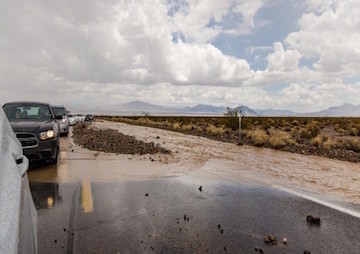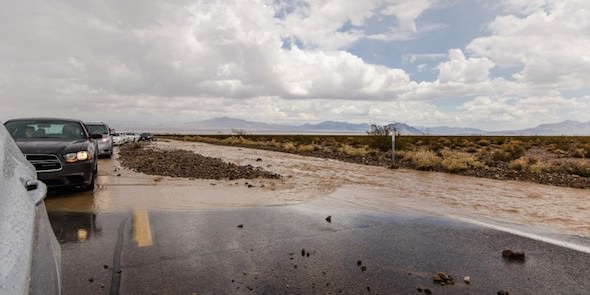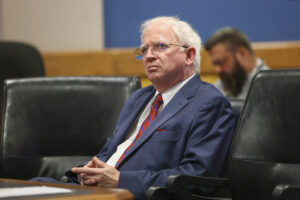Floods Will Add to California’s Drought Woes
Climate scientists predict that while the drought that has devastated the state for four years will become more extreme, it will be interspersed with bouts of serious flooding.
By Tim Radford / Climate News Network

A flash flood sweeps along a road through California’s Death Valley in 2014. (m01229 via Flickr)
This Creative Commons-licensed piece first appeared at Climate News Network.
LONDON — Drought in California could become more frequent and more extreme — but punctuated more frequently by extreme floods, according to new research.
The “Golden State” is already in the fourth year of devastating drought, and researchers have persistently warned that climate change – driven by global warming as a consequence of rising carbon dioxide levels in the atmosphere because of increasing human use of fossil fuels — could make things worse.
Jin-Ho Yoon, Earth systems analysis and modelling scientist at the US government’s Pacific Northwest National Laboratory [http://www.pnnl.gov/], and colleagues have now taken a close look at one of global climate’s great natural confounding factors, and its future role in California’s climate.
Steady warming
They report in Nature Communications that they factored in the cycle of El Niño and La Niña events — collectively known as the El Niño Southern Oscillation (ENSO) — to see how these played into the pattern of steady warming of the region.
The first is a cyclic cooling of the ocean temperatures that tends to be observed in the eastern Pacific in December at around Christmas — which is why Peruvian fishermen first christened it “The Child”. An El Niño year tends to bring heavier rains and snowfall to America’s West coast. La Niña, the cooler little sister, tends to bring drier seasons.

La Niña, left, cools off the ocean surface (greens and blues) in winter 1988; El Niño, right, warms it up (oranges and reds) in winter 1997. Image: Jin-Ho Yoon/PNNL
So Dr Yoon and his co-researchers did what climate scientists do: they simulated the climate for California from 1920 to 2005, using historical data, and from 2006 to 2080. The first stage was a test of the past to check the simulation’s reliability; the second was to see what would happen if humans went on burning fossil fuels in the now-notorious “business-as-usual” scenario.
Then they ran their simulations in two different ways. In one case, they made a compilation of 38 different climate models. In the other, they ran the same model 30 times. The more similar the results, the more sure they could be of their findings.
More oscillation
They ran their simulations with and without the El Niño factor, and put up the carbon dioxide mix in the atmosphere by 1% per year for 150 years.
What they found was more oscillation: more excessively wet, and more excessively dry periods for California as the thermometer rose and the decades ticked by. The frequency of droughts could double, and the frequency of floods could triple, between the early 20th and the late 21st centuries.
Without El Niño/La Niña oscillation, the patterns of extreme rainfall stayed constant for the whole 150 years. With it, the region experienced wide swings.
“By 2100, we see more — and more extreme — events,” Dr Yoon says. “Flooding and droughts will be more severe than they are currently. Our study shows that ENSO will be exhibiting increasing control over California weather.”
Tim Radford, a founding editor of Climate News Network, worked for The Guardian for 32 years, for most of that time as science editor. He has been covering climate change since 1988.
Your support matters…Independent journalism is under threat and overshadowed by heavily funded mainstream media.
You can help level the playing field. Become a member.
Your tax-deductible contribution keeps us digging beneath the headlines to give you thought-provoking, investigative reporting and analysis that unearths what's really happening- without compromise.
Give today to support our courageous, independent journalists.






You need to be a supporter to comment.
There are currently no responses to this article.
Be the first to respond.